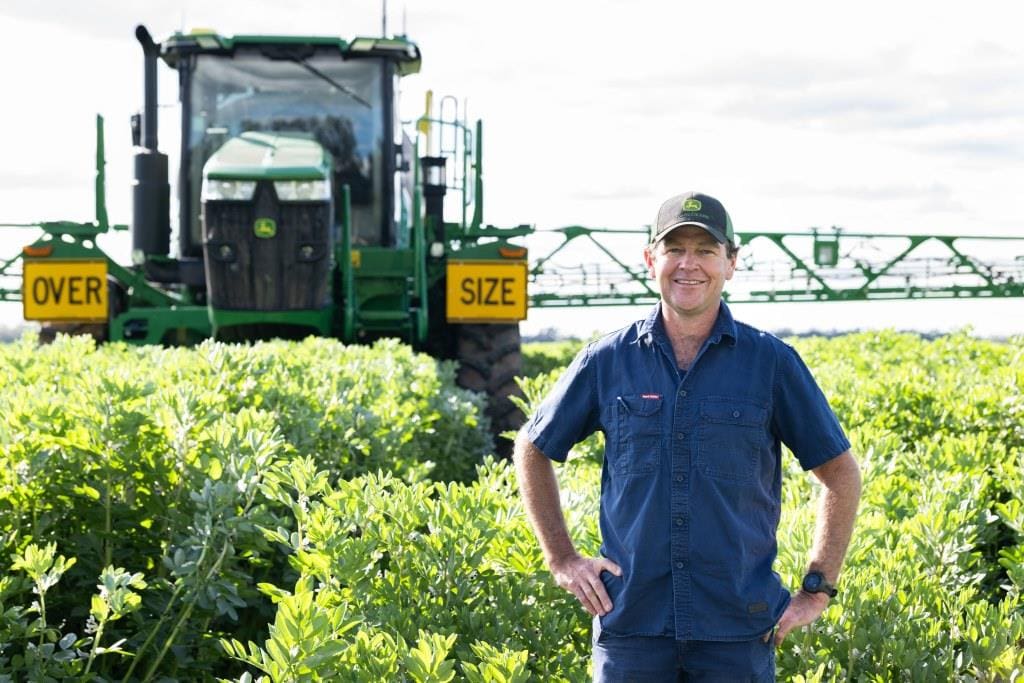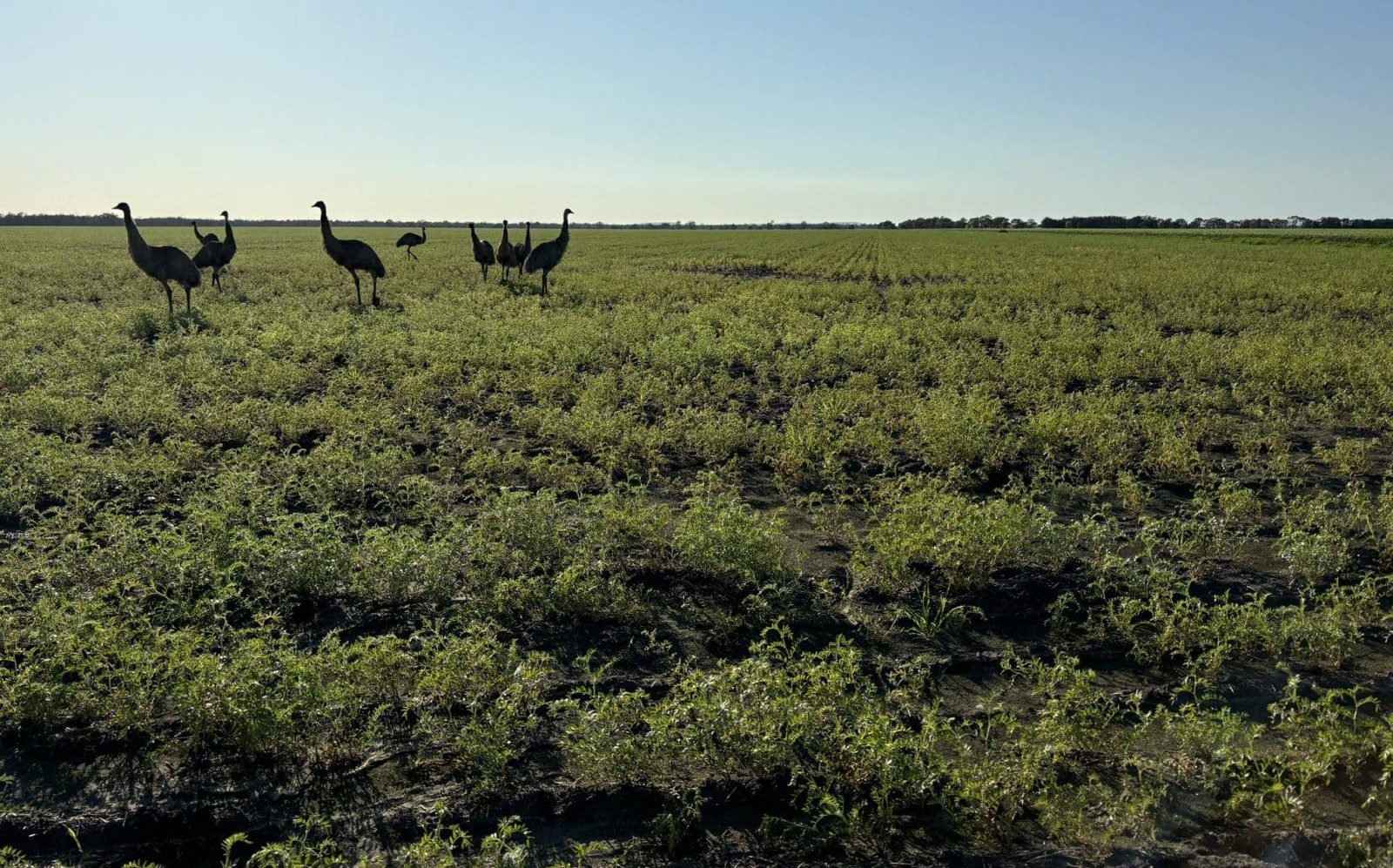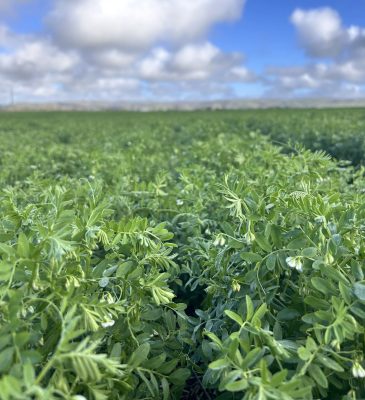
Warren, NSW, grower Richard McKay in a crop of faba beans planted April 19 and showing above-average yield potential. Photo: John Deere
BUSINESS to fill a heady new-crop shipping program out of Queensland is lifting volume and values in the chickpea market.
Lentil prices have fallen in response to more attractive offers to South Asia out of Canada as Australian stocks run down, and new-crop selling from Australian growers has dried up on lower prices and yield concerns in some areas.
On the production front, most Victorian lentil and faba bean crops are in reasonable shape ahead of the start of spring on the weekend.
In New South Wales, faba bean and chickpea crops generally have above-average yield potential, as does the Queensland chickpea crop.
Lentil crops in South Australia remain the primary area of concern, with the late start and a lack of subsoil moisture exposing some districts to yield loss if September and October bring frost, high daytime temperatures or below-average rainfall.
All prices are in Australian dollars unless stated otherwise.
Chickpeas
New-crop chickpeas delivered Oct-Nov Brisbane port are trading in volume at $1100/t, up at least $50/t since mid-July, with trade sources reporting at least 500,000t booked to load out of Brisbane’s four terminals alone by January.
They say expensive container freight rates just released for the upcoming quarter have quashed interest in the boxed market.
As an example, container freight to Pakistan is sitting at around US$85/t, compared with bulk at $40-$45/t.
“Shipping companies have started to put some rates for Q4 out and…it’s not competitive at all,” one trader said.
Bids are just starting to appear at sites in Central Qld.
Some growers are waiting for that market to develop before committing to a delivery slot, while other CQ growers have booked loads to road-freight to Brisbane at prices they saw as too good to pass by.
CQ is now competing; according to Clear Grain Exchange, the highest chickpea bid around today is A$1025/t for delivery to Mt McLaren in CQ.
One trader said exporters were gunning for the Oct-Nov slots, with Ramadan starting in late February next year the impetus to get product into Bangladesh early.
In India, uncertainty about whether the tariff-free period will continue past March has traders keen to get vessels away before the year is out, and Dec-Jan delivery is quoted at around $60/t below Oct-Nov slots to reflect the early push.
“October prices are very very strong, and they step down each month after that.
“Everyone wants to do October-November shipment.”
Sunrise Commodities broker Scott Merson said growers he deals with were anywhere from zero to 50 percent forward sold on chickpeas, with concerns about quality or harvest timing more than price behind any reticence.
“Bigger growers have enough spread on planting to know they can hit the target for that earlier delivery,” Mr Merson said.
Crops in CQ, southern Qld and northern NSW are now mostly in flower.
Daytime temperatures are forecast to pass 30 degrees Celsius in this last week of winter, but are seen to be in good shape to handle some warmth.

A family of emus wanders through a chickpea crop showing signs of waterlogging in low-lying areas north-east of Moree. Photo: Ben Boughton
Elders Miles-based agronomist Neal Stevenson said Western Downs chickpea crops were “looking fantastic”.
“With the good rain we received two weeks ago, it’s set us for above-average yields, and crops are now in full flower, with some early ones podding,” Mr Stevenson said.
The CQ and Western Downs crops generally get Australia’s desi chickpea harvest rolling, and Mr Stevenson said harvest is expected to start in the first half of October.
At Goondiwindi, independent agronomist Dave Kelly said earlier chickpeas planted from May 20 to early June have a larger-than-ideal biomass, and nearly all chickpea crops have started flowering in the past week or two.
“The mean daily average temperature is getting up now, so that will bring them on,” Mr Kelly said.
On the disease front, agronomists report patches of phytophthora, or root rot, in paddocks where waterlogging has been an issue, but this is seen as a small price to pay for recent rain which has topped up soil-moisture profiles to get crops to pod set and fill.
Ascochyta and botrytis grey mould infestations appear to be minimal or non-existent at this stage.
Chickpeas growing in NSW and Qld are generally in excellent condition, with above-average yields expected, and 1.5 million tonnes still in sight, well above the ABARES estimate of 1.1Mt released early June which will be revised next week.
Faba beans
A lack of volume to accumulate further current-crop bulk cargoes, and concerns about new-crop production in the key exporting states of Vic and SA, have limited volume traded in the faba bean market this month.
“All we’re seeing is people clearing out old-crop they have on the farm, and we’re not being overrun; anything of export value went early,” one trader said.
Feed-grade fabas are trading in thin volume at around $430/t delivered mill, but are finding it hard to compete with canola meal and soymeal.
Packers are showing little interest in top-grade fabas, which work back to a delivered up-country site price of less than $450/, largely due to expensive container rates.
“I don’t think growers will go for that,” one trader said.
Offsetting the impact of the weaker market is the minimal volume on offer, thanks to a surprisingly resilient bulk export program to Egypt which was executed despite the threat of Houthi rebel attacks in the Red Sea.
Most growers have sold their current crop at prices now at least $100/t higher than those currently offered, while feed grades have gone to graziers and mixed farmers with sheep to feed in Vic, SA, and southern NSW.
In SA, the most recent PIRSA report has put the state’s upcoming faba bean crop at 154,933t from 105,700ha, the same area as produced a 217,425t crop, or 29pc more, last season.
Lentils
Lentil prices have tumbled by up to $200/t as South Asian buying interest swings around to Canadian new-crop now hitting the bins.
New-crop bids for December-January delivery are sitting at around $700/t delivered up-country site, down from more like $900/t in the prompt market in mid-July.
“We’re up against some pretty aggressive Canadian offers,” ETG pulse trader Todd Krahe said.
“There are very minimal amounts trading.”
The Australian trade appears to have done a good job in pushing out much of its export surplus ahead of Canadian new crop, and up-country packers in the Vic Wimmera are bidding around $750-$770/t for the few current-crop parcels coming out of the woodwork.
An improved situation in Vic has largely offset a still precarious one in SA.

This crop of lentils is one of the thriving ones in SA, despite a dry and late start. Photo: Rebekah Starick
“The crop is a bit of a mixed bag,” he said of the Vic crop.
“With the warmer weather a fortnight ago…crops were starting to look thirsty.
“Now most of them have had some rain, 10-30mm over the past week, which has freshened everything up.”
Much of Vic had good summer rain, and crop roots have been able to tap into that subsoil moisture ahead of spring.
In contrast, patches of SA remain of concern because its crops were generally so late to establish, and some paddocks are going into spring with very little moisture under them.
In its latest report, PIRSA said limits to SA’s yield potential for lentils has the estimated production value similar to last season, despite a 62pc increase in area sown, and a 40pc increase in tonnage.
PIRSA puts SA’s 2024-25 lentil crop at 506,069t from a record 389,000ha, up from 362,260t from 240,200ha in 2023-24.
Grain Central: Get our free news straight to your inbox – Click here

HAVE YOUR SAY